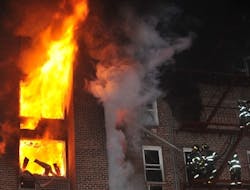Multiple Alarm Operations with Wind Driven Fire: Are you prepared?
The five alarm fire that ran through a seven story multiple occupancy (MO) apartment building in the Flatbush Section in the Borough of Brooklyn (NYC) this past weekend considerably challenged operating companies of the FDNY as the fire was fueled and spread in rapid success due to significant wind conditions compounded by news reports that a door to the fire compartment was left open, thus allowing the developing fire conditions to intensify and escalate due to the wind driven conditions that were impacting the building, the fire compartment and initial operating companies.
The seven-story MO Apartment building at 346 East 29th Street is reported to have had 70 apartments and was located midway in the city block. Arriving companies reported a fire on the number four floor and quickly deployed handlines and initiated primary search and rescue and other tactical assignments.
First-due operations, from the initial alarm assignment’s arrival, the transmission of size-up communications and the accurate and timely deployment of companies to task assignments is mission critical to an evolving incident.
The introduction of other challenges such as confronted by FDNY at this alarm further magnify the importance of effective command risk assessment, building size-up, effective and efficient company assignments and deployments with adequate resources (staffing and companies) to intervene with the fire dynamics and growth of an initial developing room and contents to an extending and escalating structure fire.
Take a few minutes to listen to the radio transmissions on the audio file on Buildingsonfire.com, paying particular attention to the exchange of dispatch communications, first-due size-up and actions, command transmissions and subsequent rapid transmittal of greater alarms, as fire ground operational conditions deteriorated due to the wind driven fire, fire extension, civilian’s in distress and rescue operations.
Think about the way you would react, interface or address similar conditions and challenges at an alarm in your jurisdiction or department.
- Do you have the necessary skills and experience to address timely actions required of company and command officers at a wind drive fire incident?
- Are you capable of addressing a large single family dwelling, or a large low rise MO apartment building? How about a townhouse or garden apartment complex building?
- How familiar are you with the required specific strategic and tactical considerations for wind driven fire incidents?
- Are you aware of the recent research and operational factors and considerations coming out of emerging research from the NIST and UL?
- How effective are your capabilities for operating at large scale multiple alarm incidents with your department’s resources, or with mutual aid or external agencies?
- Have you trained and prepared to manage multiple alarm incidents?
- Are you prepared to address rapidly changing fire ground conditions at large area residential occupancies when dealing with wind driven fire conditions?
- Are your company or command officers trained to identify key operational indictors during incident operations that require immediate redeployment of companies and tactical assignments?
- Have you read the Prince William County (VA) Fire Rescue Kyle Wilson LODD Report, as it related to a structure fire in a large area residential occupancy?
Go to Buildingsonfire.com for additional video, fireground audio and a comprehensive overview on reference and reserach links related to Wind Drive Fire Research and articles.
About the Author
Christopher J. Naum
CHRISTOPHER J. NAUM, SFPE a Firehouse® contributing editor, is a 40-year fire service veteran and a national instructor, author, lecturer and fire officer. He is an authority on building construction issues affecting the fire and emergency services and a former fire command officer, architect and fire protection engineer. Naum is a technical consultant and reviewer to the NIOSH firefighter fatality investigation and prevention program, an NFFF Firefighter Safety Advocate and formally served on the Board of Directors of the ISFSI and the IAFC Safety, Health & Survival section and faculty at the National Fire Academy. He was the 1987 ISFSI George D. Post National Fire Instructor Award recipient. Naum is the executive producer of Buildingsonfire.com and FiregroundLeadership.com, sites dedicated to building construction, adaptive fire command and firefighter safety.

